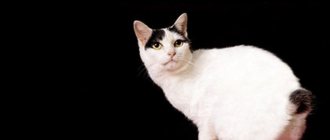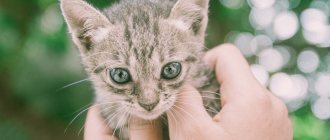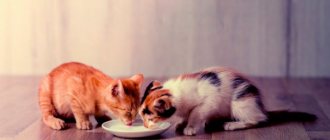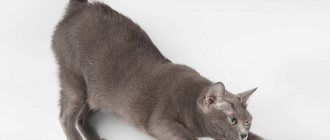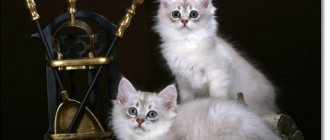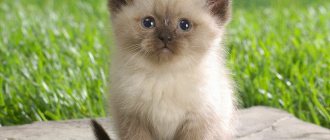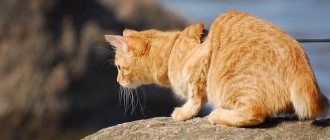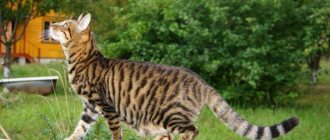It is based on the average increase for each month in the period from 1 to 12. However, when using the table data, it should be taken into account that the weight of different breeds at the same age may differ slightly. For example, Maine Coon cubs weigh significantly more at birth than British breed cubs. Several other factors also influence the weight and size of a kitten:
- Floor. At birth, boys and girls usually do not differ much in weight, but after a few months this difference becomes noticeable;
- Number of individuals in the litter. It is known that the more individuals born in one litter, the greater their deviation towards underweight from the average statistical norm;
- Proper nutrition for cats during pregnancy and feeding. If during pregnancy and feeding the cat received all the substances necessary for her body, then the likelihood of harmoniously developing offspring becomes higher;
- A balanced diet for the baby after weaning him from the cat is one of the factors that is significant in terms of influence on the kitten’s normal weight;
- The health status of the animal. Violation of general health can negatively affect the development of an individual and normal weight gain.
© shutterstock
Newborns: up to 7 days
Kittens are born deaf, blind and very small. Signs that a kitten was born recently:
- the umbilical cord on the tummy has not yet fallen off (the tail dries out by 3-4 days);
- the ears are pressed tightly to the head and seem to be overgrown (open on days 5-7);
- eyes closed;
- there are no teeth in the mouth at all;
- weight 90-120 g, tiny sizes.
It is difficult to feed such babies without a mother; it will require enormous effort. A heating pad (heat source) and cat milk replacer are needed, which is given every 2 hours.
How often do cats shed in natural conditions?
The molting process in wild cats is subject to seasonality, fluctuations in temperature and humidity, changing seasons and the length of daylight hours. Cats living in the wild, wild or stray, shed twice a year - in spring and autumn.
In September-October, the coat changes to a denser, thicker one, and an undercoat appears. The purpose of such a coat is to protect the animal from hypothermia and retain the heat emanating from the body for as long as possible. In March-April the reverse process occurs. The cat's fur coat is changed to a lighter one, which will save it from overheating.
At 2 weeks of age
Such kittens can still fit in the palm of your hand, although they already weigh about 200 g. The little ones are already capable of not only crawling on their stomachs, but also standing on their paws and walking a little. At 2 weeks the cub walks unsteadily and staggers.
Other signs:
- ears fully opened;
- the eyes have opened, but they look narrow, their color is bright blue (some kittens open their eyes even earlier - by the 10th day).
These babies readily eat formula (a substitute for cat's milk), but require special care that imitates the actions of a cat. After feeding, massage the tummy clockwise and the anus so that the kitten can defecate.
How can you find out the gender of a kitten?
There are several ways to determine the sex of a kitten. Not one of them is considered 100% accurate - it’s much more reliable to carefully examine the animal’s genitals. However, if you are unable to conduct an inspection, pay attention to other external signs. So, a cat and a cat are distinguished:
- By color. It is believed that you can distinguish a cat from a cat by looking at the color of the animal's fur. For example, the tricolor pattern is most often found in females. While male kittens most often have red fur. Tortoiseshell coat coloring is a more striking indicator, since it can only be found in cats.
- On the face. In small newborn kittens, the shape of the muzzle is the same in both boys and girls. However, with age, it can also determine the gender of the kitten. For example, cats have a small and slightly elongated muzzle, while cats have a large and round muzzle.
Dry food for kittens at six months
It is better to feed kittens with high-quality food at six months, as there will be less chance of allergies. In addition, food will become more balanced in vitamins, which is beneficial for a growing body.
Premium food
The group includes premium food leaders:
- Royal Canin . It has a low price because it is produced in Russia. In addition, there is a large assortment for any pet.
- Hills . American food with a huge range for any health problem. There are also products specifically for kittens.
- Purina ProPlan . Food made from natural meat. The assortment includes packaging for any animal.
- Eukanuba . A manufacturer that perfectly combines price with quality. The range includes both food for the daily diet and veterinary dietary products.
- Bozita . Swiss food, which is of high quality and fairly low cost.
Super premium food
These are the highest quality feeds that are quite expensive:
- 1st choice . A Canadian company that makes excellent products for cats and small kittens.
- Bosch Sanabelle . A German company that uses only natural products, without preservatives or dyes.
- Arden Grange . The company produces food from meat and rice, with the addition of probiotics, which cats really like.
Holistics
Holistic foods should be distinguished from grain-free foods. In the latter, grain is replaced with starch, but the product itself may be of disgusting quality. Holistic food is food without the addition of preservatives, flavors and dyes. Ideally, it doesn’t even contain offal, but is made entirely from meat. This is an excellent principle for creating food, but it will result in a higher price for the product.
Important! A sick animal needs to buy not holistic products, but special veterinary dietary products.
Holistic foods do not eliminate the possibility of allergies, and their quality is often no higher than super premium food. Typical representatives are the Eagle Pack company and its line of Golden Eagle Holistic food. Slightly less known are the companies Go Natural holistic and GRANDORF Natural & Healthy, which produce products with the ideal content of minerals, vitamins and probiotics.
At 5-6 weeks of age
Kittens develop very quickly. By one and a half months they have:
- deciduous premolars (chewing teeth behind the canines) are emerging;
- the eyes change color (the baby blue of the iris goes away).
Such a cub weighs no less than 250 g and can already run. The ability to move quickly is a sure sign that the pet is more than 5 weeks old. At this age, kittens look quite confident in themselves, coordination improves noticeably. The kittens begin to lick themselves.
You can switch from cat milk replacer to first food. The most convenient are the commercial diets “babycat” and “kitten”, which are allowed from 1 month. Kittens willingly eat canned food, but if finances are limited, you can also offer dry food. The small granules are easily soaked in water, and some kittens chew and swallow them in their original form.
From 6 weeks, many anthelmintics and medications for external parasites are allowed.
3rd and 4th weeks: baby in the house
The kitten's sense of smell begins to develop much faster than in the 2nd week. The kittens' vision also improves significantly, so that they can already see their mother. Good eyesight gives kittens the confidence to develop their still rather unsteady gait. Kittens' hearing also improves significantly, and ears that were previously drooping should now stand up. By the end of the first month of their lives, kittens become aware of their siblings and begin to interact with them. At the same time, they gain significant weight, their teeth begin to grow, and they begin to purr.
What can a kitten weigh at birth?
The following factors influence the initial weight of the newborn:
- breed: Maine Coons are born larger than Siamese kittens;
- gender: cats are larger than female cats;
- mother's age: firstborns and animals over 6 years old give birth to small kittens;
- number of cubs: the more kittens in the litter, the smaller they are.
If the newborn's weight ranges from 60 to 160 g, there is nothing to worry about.
Vitamins, minerals
Vitamins, minerals, amino acids must be supplied to the kitten’s body with food and feed. Ready-made high-quality feed contains all the necessary substances, so the ready-made diet is not supplemented with vitamin-mineral complexes and additives.
If the kitten receives natural food, to replenish the deficiency of vitamins, minerals, amino acids, ask your veterinarian what vitamin preparations to give your pet.
It is best to use complex formulations (Brevers, Stress Tabs for kittens) in tablets, capsules, or powder. At five months, the kitten’s body needs proteins, amino acids, calcium, phosphorus, iodine, iron, vitamins A, B, C.
2-3 months
At the age of 2-3 months, you can only focus on the size of the kitten and its behavior. By 3 months, the ears are noticeably enlarged. The veterinarian also evaluates the development of baby teeth.
During the period of 2-3 months, it is recommended to do a double vaccination against viral diseases of cats.
At 3 months the pet knows where the tray and bowl are and comes when called. Weight is about 1-1.3 kg. The first rabies vaccination is allowed from 3 months of age. Domestic kittens are most often taken to a new home at this age.
3-6 months: unlucky teenager
By 3 months of age, kittens have improved physical coordination and social skills. They begin to play with each other, including being quite rough, ambushing each other, and hugging and licking each other.
At this time, kittens, of course, already have their own teeth. Their feelings continue to develop and reach maximum values. Their social interaction reaches ever higher heights. Kittens begin to accept and recognize signals from the rest of the family, be it an animal, a dog or a person. By 6 months, some kittens become sexually mature and ready to breed. An unspayed kitten may experience her first heat, so it is wise to undergo appropriate surgery at this time.
Causes and signs of pathological molting
How can you tell if shedding is a symptom of a disease and not a seasonal natural process? Signs of pathological hair loss:
- cover change lasts longer than 2 months;
- in place of the fallen hair, bald spots remain that do not heal for a long time;
- redness, rash, ulcers appear on the skin;
- the animal’s behavior changes: it becomes nervous, irritable or, conversely, lethargic, and loses appetite.
What can cause the pathology:
- Hormonal disbalance. Endocrinological diseases, the inability to reproduce in non-castrated animals - all this can affect the condition of a pet’s coat.
- Stress. A change of environment, moving, severe fright - all this can cause hair loss. Some animals are calm about changes in external circumstances, while other cats become nervous even when a stranger comes into the apartment and tries to pet them.
- Poor nutrition. Nutrition has a significant impact on a cat's condition. The food must be balanced and contain the required amount of vitamins, macro- and microelements. If the owners give their pet food from their table or feed them cheap food, then its fur may become dull, lose its natural shine and begin to fall out.
- Allergy. One of the symptoms of allergic dermatitis is hair loss. The disease is also accompanied by itching, the cat scratches the sore spot, and non-healing wounds form on the skin. Allergies can be caused by household chemicals, medications, and food.
- Infection with parasites and fungus. The hair begins to fall out in patches, and large bald spots form. The skin itches, a rash appears, and festering ulcers appear. The animal should be taken to the veterinarian immediately, because such infections are dangerous for people and lead to serious consequences for the cat’s health.
5-7 months
After 4 months, baby teeth begin to be replaced by molars. The first to change are the incisors, then the canines. You can see a baby tooth and a growing molar side by side at the same time. If your pet has a full set of molars, he is at least 6-7 months old.
Such an animal can no longer be considered a cub - after all, even a very young cat (5-6 months) can come into heat and become pregnant. The behavior of teenage kittens changes: they begin to meow a lot, worry, and try to escape from the house.
Males can already mark territory and pester females at such a tender age. Sexual behavior provokes aggression. Young cats or female cats should not be allowed to bite or scratch people.
During this period, sterilization can be carried out, but the food must still be designed for a growing organism: the animals will mate and gain weight for several more months. From 5 months, a pet needs 3 meals a day, and from 8 months, a cat can be fed 2 times a day.
Natural food products
When feeding, be guided by what this type of animal eats in the wild. The cat family are carnivores; the basis of their diet is meat. For a 6-month-old kitten, meat by-products must make up at least 65-70% of the entire menu.
Vegetables, greens
Pets do not absorb any vitamins, amino acids or proteins from plant foods. But this does not mean that green vegetables are not needed. The fact is that cats need fiber from them, which stimulates the activity of the gastrointestinal tract.
Important! If a kitten tries to eat grass, then this is normal. This is how pets get fiber in nature.
You should not give your cat potatoes, beets, or cabbage, as they impair digestion. It is forbidden to feed bananas and citrus fruits: oranges, tangerines, grapefruits. It is better to opt for cucumbers, apples, pears, and lettuce.
You might be interested in:
- What to feed a one-month-old kitten
- What to feed a 2 month old kitten
Meat by-products
Feeding meat does not mean that you need to give your cat delicacy cuts; this includes offal:
- Liver . Rich source of vitamins and minerals. But liver should not be given to an animal often, as this will lead to hypervitaminosis and indigestion. It is better to feed 1-2 times a week.
- Heart, lungs, kidneys, tripe, udder and other offal are the main meat diet of a kitten. Heat treatment is required before feeding.
- Cartilage and bones . It cannot be given in an unprocessed form. It is imperative to pass them through a meat grinder until the bones turn into a homogeneous mass.
- Poultry meat. Due to its low price, it will become the basis of the diet. But you need to feed it carefully, since cats are often allergic to chicken. It is better to buy turkey meat.
Heat treatment is possible in two options: cooking and freezing. The first method of disinfection is more effective, but it destroys vitamins and proteins, reducing nutritional value. The second method is less effective, which is why the meat is kept frozen for at least 3-4 days, but it retains more nutrients.
Important! You should not give kittens pork - fatty meat that is difficult to digest.
At 5-6 months, meat should account for 8% of the kitten’s body weight. But at this age you need to gradually reduce the amount of meat by-products. The norm for kittens from 6 months to a year is 6% of the pet’s weight, and for adult animals – 4%. These are inaccurate numbers; an increase or decrease of up to 20-30 grams is allowed.
Dairy
Feeding adult cats
Feeding a kitten at the age of 2 months
Feeding 3 month old kittens
It is a mistake to think that a kitten is allowed to give pasteurized products from the store. Cow's and cat's milk are too different in composition from each other. At six months, it is better to feed the kitten fermented milk products: kefir, cottage cheese. The fat content must be below 5%.
Important! The kitten should not be given cheeses, cream, sour cream and other foods high in fat.
Fermented milk products are allowed to be given to the animal ad libitum. Therefore, if your pet begs for more food after breakfast or dinner (this happens often), then feed him cottage cheese or kefir.
Fish
It is used as a meat substitute, as it contains fewer nutrients and calories. It has been noticed that when fed abundantly with meat by-products, cats are cool towards fish. You can only give your pet frozen store-bought seafood. River fish contain many parasites.
Porridge
The best option would be rice or buckwheat. This is also an optional food; it is allowed to be used only if there is no money for meat or fish and only in limited quantities (no more than 50% of the diet). At the same time, you cannot feed wheat, corn or semolina porridge to your pet, and besides, they, as a rule, do not eat it.
Number of feedings, diet
At six months the kitten must be fed 2-3 times a day.
Below is the daily diet for three meals a day per kilogram of weight:
1. Breakfast : 25 grams of cow tripe, 5 g of rice porridge. 2. Lunch : 25 grams of turkey meat, 5 g of liver, 5 g of buckwheat porridge. 3. Dinner : 25 grams of raw kidneys, 10 g of cottage cheese.
The above amount of food is multiplied by the pet’s weight in kilograms. The normal weight of most domestic cats is 3.5-5 kg, with the exception of large and small breeds.
It doesn’t matter when to give meat or porridge. The number of feedings every six months no longer has the same importance, since all predators are naturally accustomed to periodic fasting. Indeed, in the wild, not every hunt for cats is successful, so they tolerate the lack of food calmly.
Raw or cooked foods
Cats are fed both raw and cooked foods. But be sure to remember the nuances:
- boiled food provides more calories, since the body spends less energy on digesting it;
- but at the same time, some vitamins are destroyed during cooking;
- cats should not be given undisinfected meat and fish;
- however, they can not be boiled, but frozen for 3-4 days;
- vegetables and herbs are given raw;
- cereals need to be boiled;
- eggs are fed in any form.
Why do you need to monitor a kitten’s weight at different periods of its growth?
Despite the large breed and individual characteristics of a kitten, changes in its weight at a certain age can be used to judge whether it is developing correctly. There is a breed standard that sets out weight standards. Deviation in either direction is not acceptable. Of course, a lot depends on the mother's milk supply. Therefore, it is recommended to feed her well.
The calorie requirement of a lactating cat is, on average, 3 times greater than for a pet at rest. Therefore, ad libitum feeding is practiced. To prevent food from spoiling, it is necessary to switch to professional nutrition with dry granules containing the necessary vitamins and other nutrients.
The industry does not produce special food for pregnant and lactating cats. Therefore, they use super premium food for kittens. This approach keeps milk production high and helps the kitten transition from mother's milk to solid food.
The weight of a younger kitten should constantly increase and double by the age of one week. Responsible felinologists weigh a newborn in the first week of life every day at the same hour. Then the frequency of mass determination is reduced and after six months monthly weighing is sufficient. Constant weight gain is considered an indicator of a pet's good health.
Be sure to read: How to care for a British kitten: feeding, training, mating features, when to vaccinate Kitten owners are concerned about moments when the growth rate drops or stops altogether.
In most cases, this is explained by the following objective reasons:
- Weaning : the transition from mother's milk to solid food requires a restructuring of enzymes.
- Deworming in preparation for vaccination. Dying parasites release toxic metabolic products, poisoning occurs, and growth stops.
- Post-vaccination complications: even if the kitten’s health worsens for a few days, there is no need to worry about it.
- Changing teeth: the pet is in a little pain, food eating decreases.
- Upon reaching six months of age, feed consumption decreases and growth rate decreases. But these are the physiological features of the development of cats.
- Puberty and the first estrus are accompanied by small plumbs.
In addition to physiological reasons for growth inhibition, pathological ones may appear: poisoning, infection or invasion.
Development of kittens by week: features, what they look like
The weight of kittens at birth depends not so much on the breed, but on the number of cubs in the litter, as well as the age of the cat. It is believed that the average weight of newborns is 100 grams. Since the standards for kittens of different breeds are not the same, you can focus on the parameters for outbred individuals.
Kittens are born blind and deaf, but they easily find nipples and do nothing but eat and sleep. Experienced felinologists recorded their observations in writing and share their knowledge with colleagues. It is useful to keep such data because it will provide an invaluable service when it comes to seeking veterinary help.
Features of development in the first week
In the first hours of life, kittens feed on colostrum. It is rich in globulins, which contain maternal antibodies. The baby’s intestines do not digest them, but pass them into the blood. Globulins will protect the kitten’s body from viruses and bacteria until 6-8 weeks of age.
The body will perceive milk proteins as foreign. The valve cells will close and only low molecular weight fragments of digested proteins will enter the blood.
On the second day, some kittens' umbilical cords fall off. By the fourth day of life, in normally developing cubs, the remnants of the former connection with the placenta are lost. By the fifth day, babies hear everything and distinguish smells. In kittens of certain breeds, the eyelids open on the 6th day of life, however, full vision is established after two weeks.
In kittens of the first seven days of life, the mechanism of thermoregulation has not formed. Therefore, they are prone to hypothermia in those rare moments when the mother leaves the nest. It is important that the windows are not opened in the room with children.
Be sure to read:
How many times a day to feed a kitten: natural products and food, norms by month
An indicator that the kitten is developing correctly is a doubling of the initial weight by the age of one week.
Development over 2 weeks
In the second week, the cubs already respond well to sounds. Eyes open, baby teeth erupt. The kids are actively crawling around the house.
The coat grows, becomes thick, and an undercoat begins to form. The susceptibility to drafts and temperature changes is reduced, but the animal is still vulnerable. The waking time gradually increases.
Development in the third week
The kitten begins to distinguish objects, his hearing is well developed. By the end of the period, the initial mass triples. The baby makes attempts to stand on 4 paws and begins to play with his mother, sisters and brothers.
But the movements are still uncoordinated and the baby constantly bumps into the walls of the den. The kitten begins to respond positively to stroking.
Development at 4 weeks
Baby teeth erupt one by one. By the end of the week, the pet has 26 of them. The baby is interested in the contents of the mother’s feeder and tries the granules, which should be constantly available to the lactating cat. To make the transition from milk to solid food easier for kittens, it is recommended to feed lactating cats ad libitum with dry kitten granules.
From three weeks of age, the granules are soaked and given to try. Every day the amount of water becomes less and less. For babies, bowls with low edges are placed so that they get used to drinking.
The kittens try to run with varying degrees of success and play with each other. At this time, it is time to accustom the animals to the tray, which is placed not far from the den. At 4 weeks, kittens should be dewormed for the first time. Worms are transmitted to babies in utero or by licking the mother's fur coat. 7-10 days before the first vaccination at 8 weeks of age, kittens are dewormed again.
Getting rid of parasites helps maintain high growth rates. At this time, it is necessary to check your pet for flea infestation. The means used to drive away ectoparasites from the mother are not suitable. Therefore, repellent shampoos are used to repel fleas.
The insecticide is washed off with water. Repeated treatment is carried out no earlier than a week later. The cat is also treated by applying drops to the back of the head or back. For a while, until the insecticide dries, the mother is isolated from the kittens so that they do not ingest a substance that is toxic to them. Anti-flea collars should not be worn on nursing females for the same reason.
Development at 5-6 weeks
A five-week-old kitten learns to wash and lick itself. The eyes change color from dull blue to the coloring characteristic of the breed. The number of feedings is 5 times a day. The cat begins to be prepared for weaning. It is believed that by the age of six weeks the kitten does not need milk and can be given to a new owner. However, an alternative opinion claims that the baby still needs instructions from the mother.
Be sure to read:
How to feed a cat correctly: natural or dry food and how many times
Some felinologists believe that the kitten should be given the opportunity to suckle its mother while she has milk. Others believe that prolonged lactation undermines the cat’s health and stops lactation by eliminating dairy foods from the diet and limiting drinking.
An alternative is the use of drugs that stop lactation: Lacto-Stop or Galastop. The babies are actively growing and by 6 weeks they weigh, on average, from 600 to 900 g. The undercoat is growing. At this point in their development, kittens are the most playful and very active, running around the apartment and getting under the owner’s feet.
7 and 8 weeks from birth
Regardless of whether the kitten is with new owners or continues the process of learning the behavior characteristic of cats in the company of its mother, it is prepared for the first vaccination, which is usually given at 8 weeks. The pet is dewormed and treated against fleas using shampoos that repel insects.
Monitor your weight gain. Two-month-old kittens weigh about 1 kg or more. The kids are litter box trained and can lead an independent life. They know how to hunt, but still sleep with their mother and littermates.
In the third month from birth
If the cub is with its mother, it continues to suckle out of habit, even when she has no milk. This time is dangerous for the kitten, because Chon tries to go everywhere. It is necessary to remove all small toys and close the doors to the balconies. The kitten becomes responsive to affection and begins to purr.
At 12 weeks the optimal time for re-vaccination occurs. 2 weeks after it, the baby is considered completely protected from the most dangerous infections. It can already be treated against fleas using insecticidal drops.
By this time, the character has already been formed, the pet goes to the tray, eats ready-made or natural food, and responds to its name. His baby teeth are fully formed. Visually you can distinguish where the cat is and where the cat is. Three months is the ideal age to change ownership and begin adult life.
Be sure to read:
The norm of dry food for cats per day, the norm of wet food: how to calculate what affects, how to measure a portion
Development from the fourth to the sixth month
The growth rate is slowing down. The pet is transferred to four meals a day, and from five months - to three meals a day. Live weight is about 1.5 kg, males weigh more, males weigh less. At 4 months, the change of teeth begins, which ends by 6-7 months.
At this time, the kitten turns into a teenager, lanky and clumsy. Reacts to danger, hisses, arches his back, growls threateningly. If a pet walks on the street, catches mice and likes to brag to its owner about its hunting success.
In the seventh and eighth months
Puberty begins. Males begin to mark, the time of the first heat comes for cats, although there are breed and personal differences. Weight reaches 2.5-3 kg, in cats and more. This is the time of making a decision about the fate of the pet: whether to participate in breeding, whether to lead a promiscuous lifestyle as a cat walking on the street, or whether to castrate.
The kitten is fed 2 times a day. Use ready-made food for kittens and teenagers of premium or super-premium class or natural products of similar quality.
Development from 9 months to a year of life
The growth rate is slowing down. Feed consumption is stabilizing. Cats are going into their first heat, but they should not be bred at this time. Hormonal contraceptives should not be used either. Ten-month-old kittens have the right to participate in expert exhibitions. By this time, motor activity has stabilized, the cat finds time to sleep and play. By the age of one, the cat is switched from teenage food to adult food.
To avoid feeding stress, the transition is carried out within 7-10 days. On the first day, 15-20% of the previous food is replaced with a new one, gradually increasing the ratio in favor of food for adults.
Weight value
Determining the weight of a pet kitten is an excellent way to assess its growth and development. If weight is gained slowly, this indicates health problems. Also, a nursing cat may have problems with well-being. The second reason for poor recruitment is a lack of nutrients (for example, many cubs were born in the litter).
Kittens are characterized by rapid growth, as in natural conditions they leave their mother at the age of 12–16 weeks. Therefore, at the beginning of their lives, they should eat a balanced and high-calorie diet. Every week the cub should gain 50–100 g. If the animal gains less, it must be shown to a veterinarian. But there are cases when a pet experiences a temporary stabilization of this indicator. Then the set resumes and proceeds at an accelerated pace.
For each breed of cat there is a special table that indicates the normal weight of the animal depending on its age. This is important to know, since the norm is directly dependent on two indicators - age and breed.
Therefore, you can find out how much a kitten of a particular breed should weigh without any problems. Do not forget that this indicator is seriously influenced by a nutritious, balanced and rational diet.
Similar article: Exhibition and hygienic haircuts for cats
Feeding kittens at six months with special food
The kitten is given only ready-made food marked “for cats”. Dog food is not suitable, as it has a completely different balance of essential nutrients. At six months, the animal eats both adult canned food and food marked “for kittens.”
Important! It is better to buy ready-made food at a pet store. There is no fundamental difference between wet and dry canned food.
The main rule when feeding this way is that the kitten cannot be given natural food. The fact is that ready-made food is balanced in all the necessary elements, and natural products will upset this balance, and hypovitaminosis will develop.
Manufacturers are divided into 4 groups:
- economy - Whiskas , Kitekat and others;
- standard - “Doctor Glauder” , “Doctor Alders” , “Gourmed” , “Ketchau” ;
- premium – “Hils” , “Proplan” , “Eukanoba” , “Happy Cat” ;
- super premium - Bosch , Nutram and other European companies.
The difference between them is primarily how balanced, nutritious they are and how much they cost. At the same time, remember that the economy and standard classes are practically the same in price, but the second group has a better composition.
Important! All prepared foods are nutritionally balanced. Therefore, you cannot simply give a kitten vitamins or microelements without a veterinarian’s recommendation.
On any food there are marks indicating how much it is given to the animal per day, the amount depends on body weight and age. These standards are mandatory. Common figures are 60-80 grams for a six-month-old kitten, but figures often vary among manufacturers.
Typically, the company writes the composition of the food not for each granule, but for the entire package. That is, if you don’t eat enough of the package, there is no guarantee that the kitten received nutrients in the quantities specified by the company. Therefore, when moving from one company to another, you need to finish the previously purchased pack. In this case, the manufacturer guarantees that the body will receive the composition that is written on the packaging.
Important! Even super premium food can cause allergies. Quality only reduces the likelihood of an allergic reaction, but does not eliminate it.
The most common mistake is to leave food in the bowl so that the animal eats when it wants. It is not right. When exposed to air, food oxidizes. Vitamin A is the first to be destroyed by oxygen. Then other beneficial substances are oxidized.
Why does a kitten weigh less than normal and what to do about it?
There is no need to panic if the baby’s weight is slightly below normal, but he is cheerful, active and does not have any alarming symptoms such as vomiting, diarrhea, excessive salivation, dull hair, etc.
If there is significant underweight, when the kitten's ribs and pelvic bones are visible, you should immediately contact a veterinarian. Frequent reasons for such deviation:
- Starvation. A hungry kitten looks exhausted, lethargic, has bloating and diarrhea, and in severe cases, symptoms of rickets and anemia. Underweight may be due to a lack of mother's milk or an unbalanced diet when the kitten has already been weaned. It is necessary to increase the volume of mother's portions by 2–3 times during lactation. If this measure does not give the desired result, you need to supplement the baby with formula milk.
- Taste of milk. Sometimes a kitten refuses mother's milk because of its bitter taste, which appears due to the cat's postpartum illness (for example, mastitis or acute metritis). The baby looks exhausted, meows pitifully, and has bloating, diarrhea and redness of the anus. In order not to provoke blood poisoning, the baby is transferred to artificial feeding and detoxification therapy is carried out.
- Parasitic disease. A sick pet, despite a good appetite, does not gain weight. The baby has a tight belly, dull fur, sometimes constipation or diarrhea, traces of blood, mucus and parasite eggs are visible in the stool. The developmental delay is due to exhaustion: the incoming nutrients are spent not on the growth of the kitten, but on maintaining the vital activity of helminths. Worm infestation is especially dangerous at this age and can be fatal, so you should immediately contact a veterinarian.
- Diseases of the gastrointestinal tract. In this case, the kitten even loses body weight, because due to the disease, the mucous membrane of the digestive tract is affected, and nutrients are no longer absorbed by the body. A sick baby experiences symptoms such as vomiting, fever, excessive salivation, changes in stool, etc. A complete cure requires complex therapy, including not only treatment of the underlying disease, but also vitamin therapy and special nutrition.
How much do adult cats weigh?
Lifestyle, castration, nutrition, maintenance - all these are factors directly related to a cat’s body weight. The life of an adult cat differs little from that of a kitten if it lives in a family. The main thing is to prevent underfeeding or overfeeding the animal, otherwise problems with the gastrointestinal tract may arise.
A domestic cat usually weighs between 2 and 7 kg. A lot depends on the breed, and also on age. By old age, the pet will weigh less than, for example, at 2 years. And a Siamese cat will weigh less than a Norwegian Forest cat. Persians and British will weigh on average about 6 kg. But the weight of a Maine Coon can reach 13 kg.
Outbred cats are often 1 kg lighter than purebred cats. This applies to both females and males.
Mongrel cats
British
Maine Coon
Why is the baby overweight and is it dangerous?
At this age, this problem is most often associated with overeating and insufficient physical activity. In most cases, this disorder is diagnosed in domestic cats that do not walk outside.
An extra 100 g of weight is not dangerous for a pet, but a significant excess of the norm, if not eliminated in a timely manner, provokes the development of diseases such as diabetes and arthritis, as well as pathologies of the cardiovascular and excretory systems.
Most often, the problem of excess weight is solved by reducing portions. As a rule, at 7–9 months, at the height of puberty, the cat’s weight returns to normal. Much less often, obesity becomes a consequence of systemic diseases. To determine whether excess weight indicates pathology, you need to examine the kitten's waist. Normally, the ribs should not be noticeable, but easily palpable. If your fingers “sink” when you feel them, it is difficult for the animal to move, it is lethargic and apathetic, you need to contact a veterinarian.
Share with friends!


